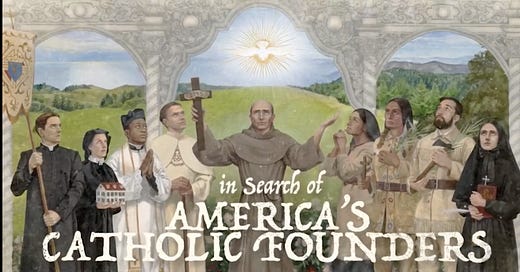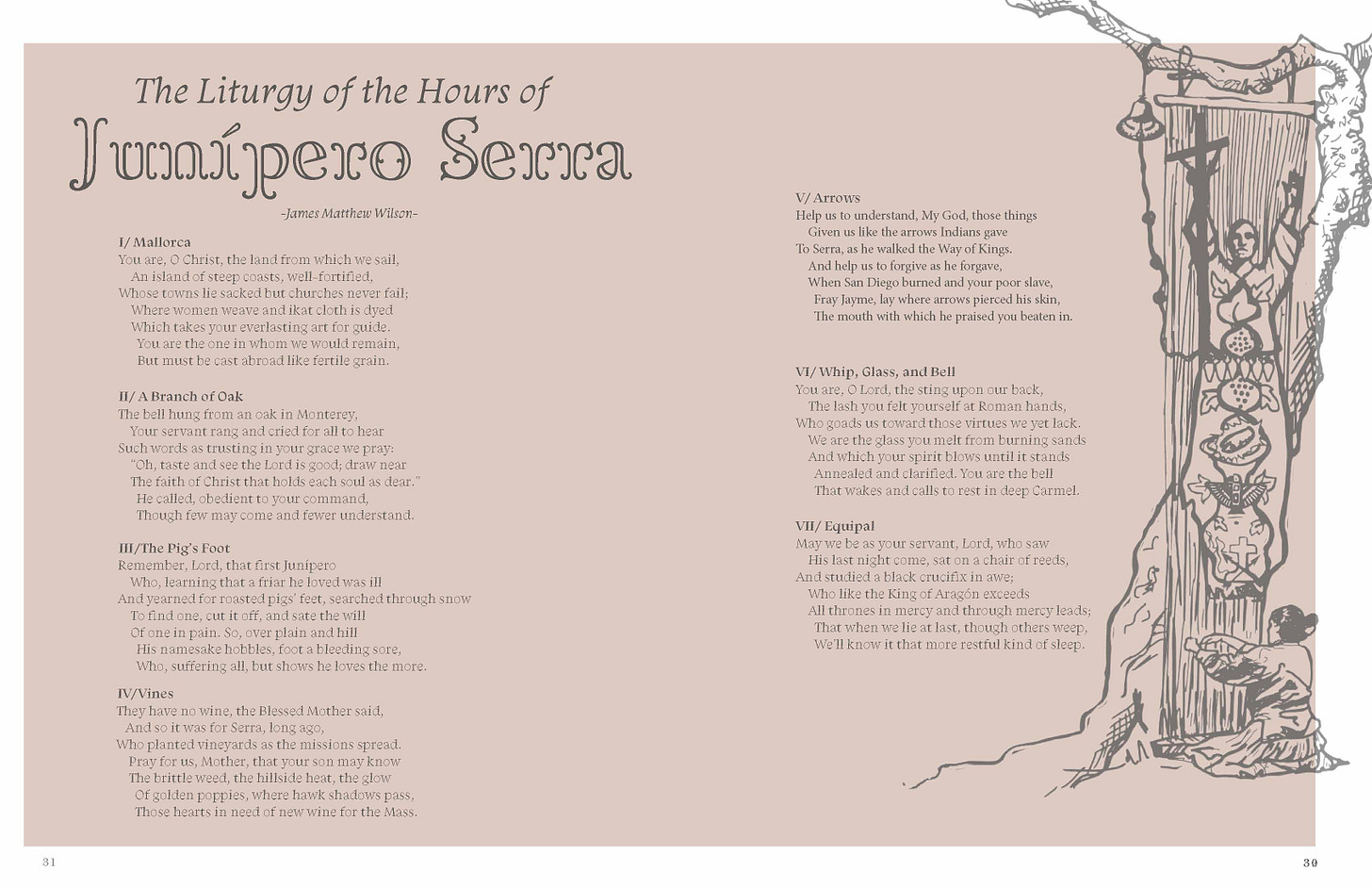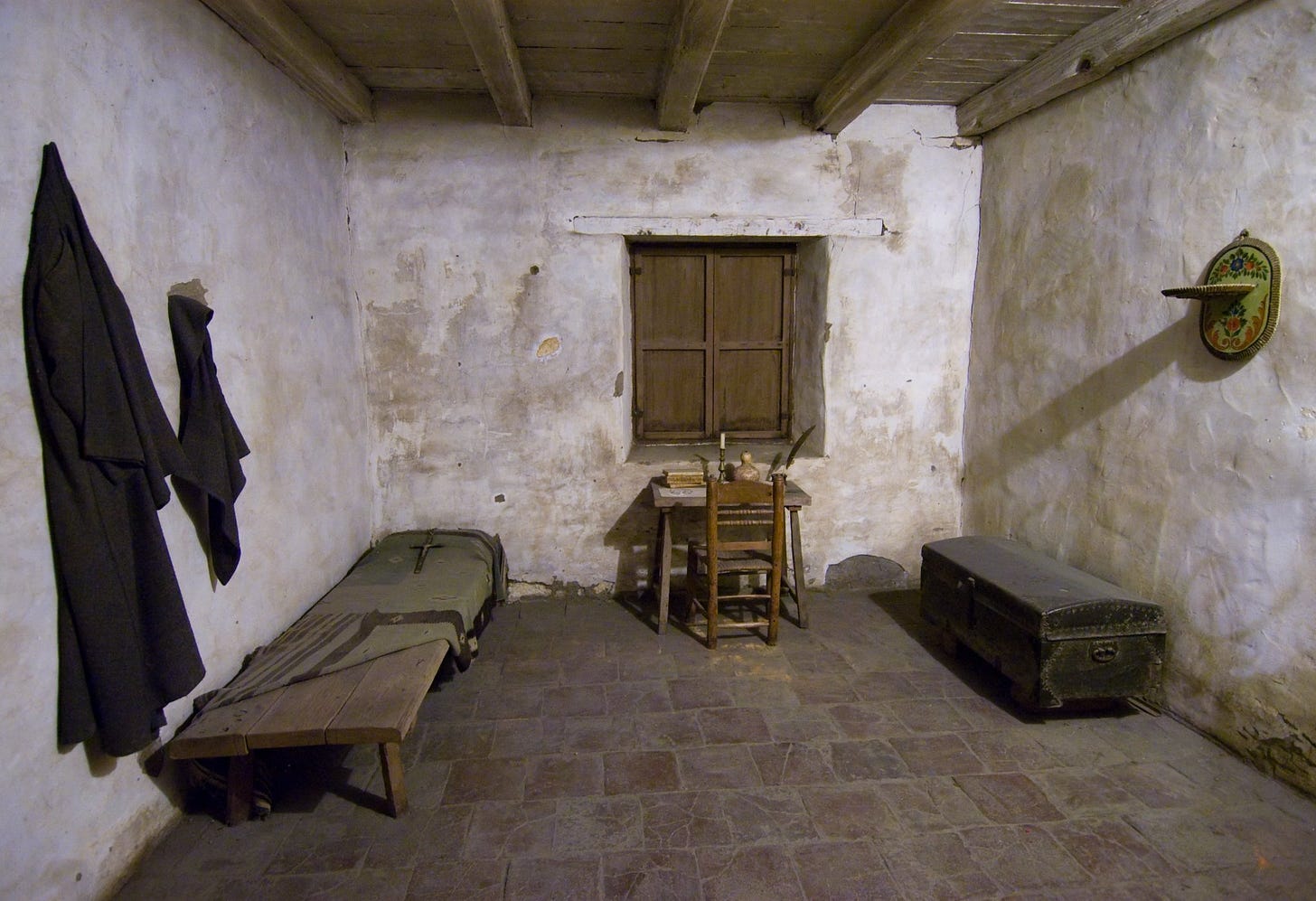Remembering St. Junipero Serra on July 1
His optional memorial is on July 1 in the new calendar, and we need to remember him not only as a self-sacrificing holy man but also as one of the first founders of our nation.
There's a lot of ignorance of the real history [of the U.S.]. I'd ask our people to learn about the history of Father Serra, of the missions, of the whole history of the Church, so that they can appreciate the great legacy the Church has given us.—Archbishop of San Francisco, Salvatore Cordileone
Remembering St. Junípero and the first missionaries changes how we remember our national story. It reminds us that America's first beginnings were not political. America's first beginnings were spiritual.—Los Angeles Archbishop Jose Gomez in a 2017 homily, praising St. Junipero Serra as an overlooked American founder.
Archbishop Cordileone and Archbishop Gomez are asking all of us to learn and to teach about all of America's founders, to correct the dominant myth of the Puritan founding of our country. Most of us have only heard part of the story. The truth of our history is a gift we need to learn for ourselves and to pass on to others.
My family moved around a lot, so I grew up in and around Boston, Massachusetts, one center of the American Revolution. Like all schoolchildren, and probably more intensely as a Massachusetts-raised child, I learned in American history classes that our nation was founded by brave Puritans seeking freedom of religion. Descendants of the Puritans came to be honored as if they were a new royalty in the country. But the Puritan’s story is only part of the story.
The rest of the story is that many of America's founders are Catholics. One of the most prominent of these saints is St. Junipero Serra, who is called the Apostle to California.
I was asked over two years ago to write a book about St. Junipero Serra and several of the many saints who gave their lives, often literally as martyrs and always by dying to their own comfort and ambitions. By their lives and deaths and self-sacrificing examples, in many varied ways, they brought the blessings of the Catholic faith and the beauties of Catholic culture to North America.
I’ve been distracted by many other writing projects since the idea first came up. All the while, Stewart Shipley, my patient traveling companion and prayer partner, has been praying for St. Junipero Serra’s intercession to help me get back to working on the book, and lately he reminded me that at one point (which I don’t remember) I committed to spending ninety minutes a day on writing it. So now he’s refreshed my memory, I’m back on the project, come what may in the line of health-scares, weekly Substack commitments, or poetry contest deadlines.
Finishing the book soon would be especially timely because the 250th anniversary of the founding of the Mission Dolores will be celebrated on July 29, 2026 as the founding of San Francisco.
St. Junipero Serra, as most of us know, was the founder of most of the California missions, and he directed the founding of the Mission in San Francisco.
I've visited many of those missions and heard slanderous remarks about the work of the missionaries, even from docents who lead tours. It is important to speak the truth about the missions in the midst of the lies that have spread about the methods and the motivations of the missionaries.
St. Serra is buried at Mission Carmel, and Stewart and I have visited his tomb there to pray for the book I’m writing to be a vivid witness to him and the other saints who, in various ways, brought the blessings of the Catholic faith and the beauties of Catholic culture to North America.
It only recently dawned on me how anti-Catholic the Puritans were. The Puritans were trying to purify the Anglican faith from any remaining traces of adherence to Catholic doctrine and worship. They had fled England for freedom to worship the way they wanted, but it’s now striking to me that they left because they loathed Catholic practices, which they called popery. And it’s also striking that in setting up the rules for the colonies they were founding, most of them did not grant to others the religious freedom they were seeking for themselves.
So one of my goals is to show how the Puritan story is only part of the story.
For more than a century there was no Christian presence in what we now know as the United States except the Catholic one.—Charles A. Coulombe, Puritan's Empire
As one step towards that goal, I am republishing this post from a year ago.
Feast Of Junipero Serra (New Calendar)
The Fathers of Our Nation
From the British Colonies on the East
And the Spanish Colonies on the West
As Archbishop Cordileone tweeted on the Feast of St. Junipero Serra, July 1, 2023. "While they were starting a revolution on the East Coast, he was founding the city of San Francisco with Mission Dolores. ¡siempre adelante!"
"Let's remember ALL the great founders of America this 4th of July."—Maggie Gallagher, B16 Institute Executive Director.

The image above is from a documentary titled "In Search of America's Catholic Founders: St. Junipero Serra"that first aired on EWTN. (You can see more of Bernadette’s work here.) In the documentary, Archbishop Cordileone and others explore St. Junipero's legacy in the light of today's cancel culture and talk in some detail about St. Junipero Serra as the founder of America. You can view it here.
The video is an eye-opener about many aspects of St. Junipero Serra’s work. One revelation is how close in time the creation of the missions in California on the west was to the Revolutionary War, which was the beginning of the fledgling United States on the east.
One Way the Missions Helped the American Revolution
On June 21, 1779, Spain declared war against Great Britain, thus contributing to the success of the American Revolution, which had begun with the first battles between the patriots and the British at Lexington and Concord in 1775 and the Declaration of Independence in 1776.
In 1789, St. Junipero Serra was tasked with organizing public prayers for the prosperity and success of Catholic armed forces [in the Spanish army]. Another order from Madrid in 1781 instructed the collection of donations to support the war effort:
"[E]ach Spaniard was required to donate two pesos, while every Mission Indian was expected to provide one."
Serra explained in a letter to his superior the difficulty of collecting one peso each from each Indian, "Many do not know what the word means and cannot understand that you need money to make wars. In their own experience they often go to war and are not bothered about money. Still less can they understand that the King of Spain, our Lord, should need a peso from them."
Ultimately the money for the war tax was paid from the priests' own Mass stipends, from the sale of produce from the missions, and from the collection of debts from the soldiers. And through this money, it can be said that Alta California made a contribution to the victory of the United States against the British in the Revolutionary War.
Similarities Between St. Junipero Serra and George Washington
As "The History of Father Junipero Serra and Washington" at Catholic News Agency mentions, "George Washington (1732-1799) and Junípero Serra (1713-1784) were contemporaries in ideals as well as in time."
Washington is called the Father of his country, which at the time was about a 10th of the land mass of what eventually became the United States.
There are indisputable grounds for also recognizing that Junipero Serra was a founding Father of this nation, at least he is the Father of Alta California, which was the portion of Mexico that eventually became the state of California, the thirty-first member of the American commonwealth.
He was also called the Apostle of California.
"THE handsomely-fashioned bronze likeness of Fray Junípero Serra, located in the Statuary Hall of the nation's capital, appropriately faces the one depicting George Washington. Surely there was something more than coincidence in the proximity of the two great pioneers, one the "Father of his Country," the other a "Father" of his Church.” "George Washington (1732-1799) and Junípero Serra (17131784) were contemporaries in ideals as well as in time. They worked for a common cause, each in his own sphere.”—From “The History of Father Junipero SerraL Serra and Washington, by Msgr. Francis J. Weber.
In spite of petitions to replace the Serra statue with a statue of astronaut Sally Ride, the Serra statue was still standing in the Statuary Hall as of February 12, 2023, according to “Junipero Serra statues have come down in California. Why does state still have one in US Capitol?”—which is the latest article on the topic I can find.
Archbishop Cordileone’s Defense of St. Junipero Serra
I’ve written several Facebook posts and articles about what Archbishop Cordileone and his Benedict XVI Institute are doing to defend St. Junipero Serra’s reputation against atrociously unjustified slanders. As I described in “Defending St. Junípero Serra, with Holy Water, the Rosary—and the Arts,” the archbishop has been using not only words but religious tools at his disposal, and he has also been using the arts. Religious tools included prayer and fasting. He quickly performed an exorcism after Serra's statue was pulled down in Golden Gate Park, as described in “San Francisco archbishop performs exorcism at site of destroyed St. Junipero Serra statue.”
Sponsoring the arts is the more uncommon means the archbishop has used to defend the legacy of St. Junipero Serra. He commissioned “Missa Sancti Juniperi Serra” from the Benedict XVI Institute composer-in-residence, Frank La Rocca. He commissioned the painting “St. Junipero Serra and the American Saints” from Bernadette Carstensen. And he commissioned James Matthew Wilson to write a poem!
On July 1, 2022, St. Junipero's feast, Archbishop celebrated a Solemn Pontifical traditional Latin Mass at which Misa Sancti Juniperi Serra premiered. The Mass was celebrated in the Mission Dolores basilica which is adjacent to the site of the San Francisco mission where the first Mass was celebrated.
The Making and the Premier of Missi Sancti Juniperi Serra
Above is a link to a ZOOM session on The Making of the Missa Sancti Juniperi Serra and below is a link to a video of the Solemn Mass for the Feast of St. Junipero Serra that was celebrated at the Mission Dolores Basilica in San Francisco with the premiere of La Rocca’s Mass setting “Missa Sancti Juniperi.”
Correcting the Slander of Exploitation
In September 2022, my traveling buddy Stewart Shipley and I drove to Mission Carmel, where St. Junipero Serra is buried. I was happy to revisit the little mission museum and see again the sparse cell where the saint died.
At the museum website, I found a review that's a great corrective to the slander by those who are pulling down his statues: detractors claim Serra kept the conversos (native converts) in slavery and committed cultural genocide.
The reviewer wrote, "Walking through the primitive furnishings and reviewing the very basic library housed in the place, with tools and instruments available a couple of centuries ago illustrates the very primitive conditions in which the inhabitants lived and worked and the sacrifices made by the man that brought European culture and civilization to this part of America.” Instead of making themselves rich and living in comfort, at each mission one or two friars took care of thousands of conversos, performing the immense labors of making sure all were fed, and clothed, and housed, and were taught the faith and how to farm and ranch and build and live in permanent housing and were taught how to worship God in the most beautiful churches they could build.”





Busy weekend. Finally read it all. Wonderful! I would expect that in your research you have come across (or will come across) Fr. Noel Moholy’s name. He was the vice-postulator for the canonization cause of Junipero Serra. He also officiated at my parents’ wedding and baptized my brother and me at the Old Mission in Santa Barbara. I still miss him DEARLY! Whenever he would hit a speed bump in the cause, he would just address the “Old Man” as he called Serra and let him know he needed help. It ALWAYS worked. 🥰
I can’t wait to read all of this after Mass today! Just to show how far we’ve fallen, our 4th grade PUBLIC SCHOOL operetta in California in 1959 was on Junipero Serra and the missions! I can even remember my (few) lines and the name of the boy who got to play Serra!